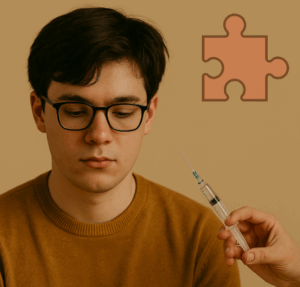🧠 Ketamine and Autism: Exploring a New Frontier in Neurodevelopmental Care
 Autism Spectrum Disorder (ASD) is a complex neurodevelopmental condition characterized by differences in communication, social interaction, sensory processing, and behavior. Traditional approaches focus on behavioral therapies, educational interventions, and sometimes medications for comorbidities like irritability or anxiety.
Autism Spectrum Disorder (ASD) is a complex neurodevelopmental condition characterized by differences in communication, social interaction, sensory processing, and behavior. Traditional approaches focus on behavioral therapies, educational interventions, and sometimes medications for comorbidities like irritability or anxiety.
But could ketamine, best known as a fast-acting antidepressant and NMDA receptor antagonist, hold potential for certain dimensions of autism — especially emotional flatness, rigid thinking, and social withdrawal?
The idea is controversial, but intriguing.
🔬 Why Consider Ketamine in Autism?
✅ 1. Glutamatergic Dysfunction in Autism
Multiple studies have shown that autism may involve dysregulation of the glutamate/GABA balance — especially in:
-
Prefrontal cortex
-
Amygdala
-
Temporal lobes
Ketamine modulates the NMDA receptor, a subtype of glutamate receptor. By transiently inhibiting these receptors, it:
-
Triggers a glutamate surge
-
Activates AMPA receptors
-
Promotes BDNF release and synaptogenesis
These changes may enhance cognitive flexibility and social responsiveness, at least temporarily.
✅ 2. Hypoactivity of the Default Mode Network (DMN)
ASD is often associated with:
-
Reduced functional connectivity in the DMN
-
Difficulty with theory of mind, self-reflection, and empathy
Ketamine transiently disrupts the DMN and may “loosen” rigid thought loops, allowing new connections and insights to emerge.
✅ 3. Emotional Blunting and Apathy in Some Autistic Profiles
Adults and adolescents with “aloof” or emotionally disengaged autistic presentations may show:
-
Anhedonia
-
Reduced affective resonance
-
Flat facial and prosodic expression
These features resemble “negative symptoms” in schizophrenia — a domain where ketamine has shown experimental promise in enhancing motivation and reward anticipation.
🧪 What Does the Research Say?
⚠️ Limited but Emerging Evidence
-
Epidemiological Observations: Some reports describe increased social responsiveness in ASD patients treated with ketamine for unrelated conditions (e.g., depression, pain).
-
Case Reports: Small case studies have documented temporary improvements in verbal communication, eye contact, and reduction in irritability after low-dose ketamine infusions.
-
Animal Models: Rodent models of autism show that low-dose ketamine improves:
-
Social exploration
-
Ultrasonic vocalizations
-
Synaptic spine density
-
-
Overlap with Fragile X and Rett Syndrome Research:
-
Both conditions involve glutamate hyperexcitability, and ketamine has shown benefit in some preclinical studies.
-
However, randomized controlled trials in humans with ASD are scarce, and long-term safety remains unknown.
🧘 Clinical Profiles That May Benefit (Hypothetical)
| Profile | Rationale |
|---|---|
| Adolescents/adults with flat affect and apathy | Similar to treatment-resistant depression; ketamine may lift “emotional fog” |
| Autistic individuals with co-occurring anxiety/PTSD | Ketamine is effective for trauma-related rigidity and dissociation |
| Those with social withdrawal or catatonic features | Brief disinhibition may “restart” social engagement |
| Adults with rigid cognitive loops and intrusive thoughts | Ketamine may increase mental flexibility |
❗Note: These are theoretical and experimental uses only — not approved indications.
⚠️ Risks and Ethical Concerns
-
Overstimulation: Some autistic individuals are hypersensitive to sensory input; ketamine’s dissociative effects may be distressing.
-
Unpredictable reactions: Communication limitations may hinder accurate assessment of internal experience.
-
Dependency risk in those with high novelty-seeking or impulsivity.
-
No long-term safety data for use in children or adolescents with ASD.
🧠 Mechanisms of Potential Benefit
| Mechanism | Effect |
|---|---|
| NMDA antagonism → AMPA stimulation | Enhances plasticity and sociability |
| BDNF/mTOR activation | Promotes synaptogenesis |
| Disruption of rigid prediction models | May reduce repetitive behaviors |
| DMN modulation | Supports emotional self-awareness |
🔄 Can Ketamine Be Combined with Autism Therapy?
Emerging thought suggests ketamine as an adjunct, not a standalone treatment:
-
Administer low-dose ketamine in a structured, therapeutic setting
-
Combine with speech therapy, CBT, or relationship-based therapy
-
Use the “afterglow” period (12–48 hours) to introduce new social or cognitive skills
💬 Anecdotal Observations (Non-Research Use)
“My adult son with high-functioning autism became more emotionally responsive after one low-dose infusion for depression. He smiled for the first time in years.”
– Caregiver (personal communication, de-identified)
“I felt like I could finally talk about things I never had words for.”
– 19-year-old autistic client post-ketamine therapy
📘 Final Thoughts
The role of ketamine in autism is not yet clearly defined — but as our understanding of ASD moves beyond behavior into brain circuit dynamics, therapies like ketamine may find a future role for specific subgroups.
Caution, ethics, and rigorous research must guide its use. But for individuals where traditional interventions fall short, ketamine may someday offer not just relief — but a reconnection with emotion, self, and others.
Written by:
Dr. Srinivas Rajkumar T, MBBS, MD (Psychiatry)
Consultant Psychiatrist
Apollo Clinic, Velachery, Chennai
📧 srinivasaiims@gmail.com | 📱 +91 85951 55808
🌐 www.srinivasaiims.com
Interested in understanding whether cutting-edge therapies like ketamine may help in complex neurodevelopmental profiles? Reach out for an informed, ethical discussion and individualized planning.